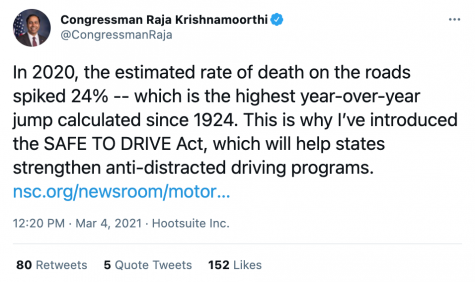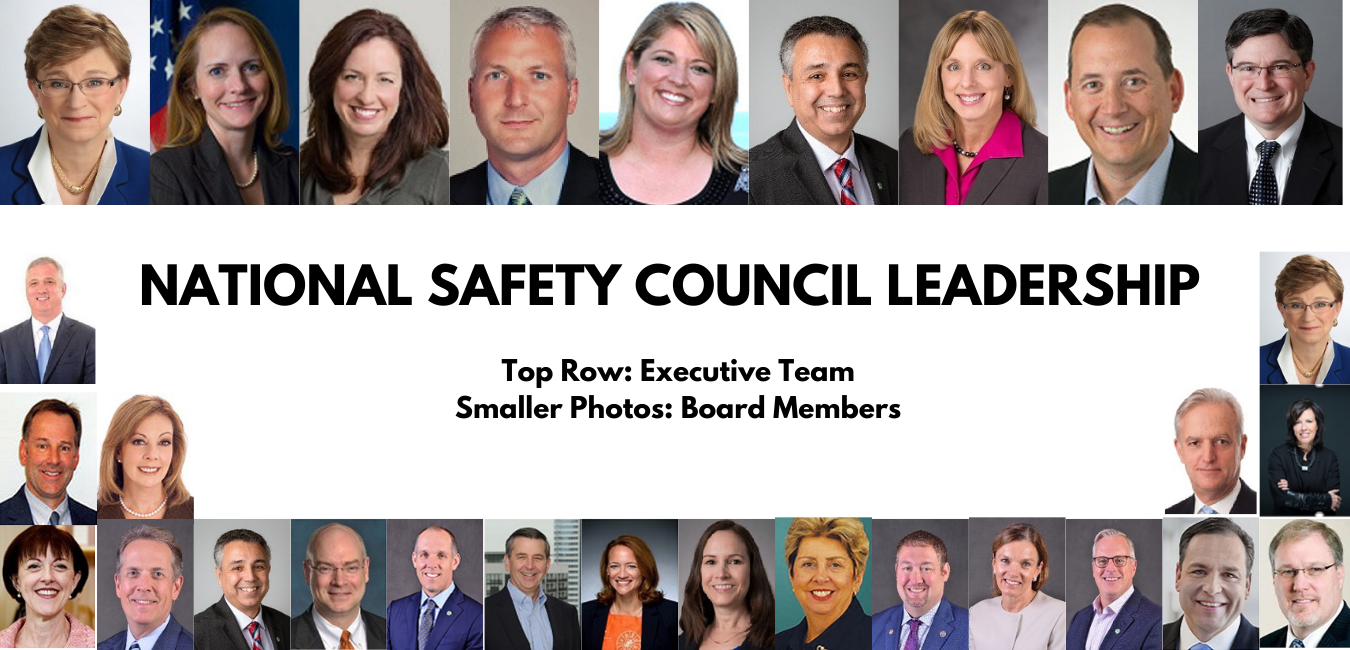Our highways were not more dangerous in 2020
Congressman Raja Krishnamoorthi tweeted today about the NSC and Road To Zero Coalition’s research about highway safety. He then announced that he’d introduced the Safe to Drive act. This act would strengthen anti-distracted-driving programs, fund innovation, and increase traffic policing. No thank you, Congressman.
Congressman Krishnamoorthi’s proposal claims to be evidence-based, claims that it will reduce traffic fatalities, and claims to create a culture of safety. I don’t doubt that it was written with good intentions. I do doubt it was written with good data. No data from 2020 can be seen as predictive for any other year. Everything from commutes to emergency services was aberrant.

I recognize that the National Safety Council has provided Krishnamoorthi with a mountain of evidence that this stack of initiatives and bundle of cash will save lives, but before we examine the flawed evidence I would ask that we also examine the researchers. I went to the National Safety Council’s website and grabbed the bio photos from the board of directors and the C Suite.

I looked very hard at the faces of leadership here and I didn’t see anyone who might have gotten The Talk when they were little. The Talk is one that Black parents have with their children early and often. The Talk is how to survive a police encounter.
Right now a parent is teaching their Black child how to survive an encounter with an American Police Officer.
Because this is our tragic reality, no laws, policies, or mandates large or small should be made without Black and Hispanic leaders. I’m not calling for employees to be involved, but leaders. I cannot elaborate on what those Black and Hispanic leaders would bring to the table, I don’t know the details because I’ve never lived them.
The faces of leadership at NSC are faces I recognize. There’s nothing wrong with middle-aged white people, I am one, and I’m married one, but you shouldn’t trust us to make legislative decisions about your Black son or Latinx daughter’s life. We’re not qualified. Yes, I recognize that not every face is white but just wait until you see the recommendations. The document is troubling to me, and intellectually dishonest.
Interestingly the letter (petition) that the Congressman and NSC are asking americans to sign goes into detail about the protections they want to offer low income and BIPOC. There is some level of awareness that not all Americans are offered the same opportunities and I find that encouraging.
Research shows that BIPOC and low-income people in the U.S. are more likely to be killed or suffer severe injuries while walking. This is because these neighborhoods have been disinvested over time, including a lack of adequate sidewalks and bikeways, and an over-abundance of fast-moving, dangerous roadways. Studies also show that communities of color and low-income communities are disproportionately burdened by some programs and policies intended to support traffic safety, such as those around jaywalking and other enforcement strategies that do not address underlying needs for safe built environments and equitable policies. Work towards #ZeroTrafficDeaths must not further exacerbate harm to these communities, but rather elevate equity and justice in traffic safety strategies.
Call on President Biden to End Traffic Deaths
#ZeroTrafficDeaths
Unfortunately, awareness of the disparate realities of Americans did not guide the NSC or Congressman Raja Krishnamoorthi as much as one might hope. I’m stunned that Congressman Krishnamoorthi hasn’t given more thought to the consequences of empowering the police in the manners suggested by NSC. Now, to dissect the press release that Congressman Krishnamoorthi enthusiastically shared.
“The preliminary estimated rate of death on the roads last year spiked 24% over the previous 12-month period, despite miles driven dropping 13%.”
I am not prepared to argue that this data is anything other than tragic. I will, however, argue that no policies should be made based on data from 2020. 2020 is a year without parallel, we had a global event that skewed every dataset on Earth. Curbed covers many of the things that went sideways in New York, including the fact that the people out driving are the ones most likely to take risks.
According to NHTSA traffic fatalities were down 1% in the first quarter of 2020.
This country effectively shut down in mid to late March. Therefore it was only during the last nine months of 2020 when American deaths on roadways spiked. During the last nine months of 2020 our emergency rooms were at and over capacity, ambulances were unable to transport patients, roads were empty, speeds were higher, and every single American was stressed in ways we were sometimes unable to articulate. Our roads didn’t get more dangerous in 2020, and though they could be safer, the sky is not falling. 2020 was a dreadful year for public health. It might not have been the roads, let’s figure out what the cause is before shotgunning solutions.
National Safety Council Recommendations
Here we have the text of the NSC Recommendations and I’ve taken the time to highlight some of questions that should be answered before any further actions are taken.
Equitable implementation of roadway safety laws, policies, procedures, infrastructure improvements is sorely needed. Communities of color are disproportionately impacted by motor vehicle crashes, roadway policies, lack of access to public transportation and poor infrastructure, among other critical elements that make a safe system.
Even as NSC plainly addresses the problems of policing in America this call to add traffic stops is perilous for many of our citizens. The LAPD Inspector General’s most recent report about traffic stops is damning, and ought to serve as a cautionary tale. Traffic stops are routinely made my officers who are looking to identify gang members and other criminals. Interestingly one of the first recommendations from the Inspector General is, “Refocus the Department’s strategies for addressing violent crime away from the use of pretextual stops, broadly defined as the use of minor traffic, bicycle, or pedestrian violations for the purpose of conducting a criminal investigation unrelated to that violation.” After a year of civil unrest was anyone listening? Why would we add more traffic stops?
Mandatory ignition interlocks for convicted drunk drivers, lowering state BAC levels to .05 and better education about the nature of impairment and when it begins
Lowering – not raising – speed limits in accordance with roadway design, using a safe system approach
Installation and use of automated enforcement to support safe speeds and adherence to traffic lights
“NSC encourages communities and states to adopt best practices for their use, including engineering, maintenance, calibration, yellow light timing, testing, camera placement and use of photos only for traffic safety and pursuit of criminal activity.” The pursuit of criminal activity is a pretty alarming group of words. Do you know what it means? Does anyone? This is carte blanche for police to target citizens as they go about their daily lives. There appears to be no limits to the rights the National Safety Council will cede up on behalf of America.
Laws banning all cell phone use – including hands-free – should extend to all drivers, not just teens. States with existing bans need to upgrade enforcement from secondary to primary.
This is absurd. Modestly priced vehicles now rely on consumers to bring their phone’s technology to the car. Automakers cannot compete with the speed of app developers and should not be forced to. Again, we compounding the already existing policing problems for low income Americans. Further, those who cannot afford cars with the latest technology will lose access to navigation, music, and traffic news or risk a ticket. Has anyone thought of the implications of this on lower income americans?
Seat belt laws should be upgraded from secondary to primary enforcement and restraint laws should extend to every passenger in every seating position, in all kinds of vehicles
Primary enforcement means citizens will be pulled over for not wearing a seatbelt. I cannot imagine a scenario where this isn’t abused by police.
All new drivers under 21 – not just those under 18 – should adhere to a three-tiered licensing system for novice drivers
Automated Driver Assistance Systems (ADAS) that have life-saving potential should be standardized and accelerated into the fleet
Motorcycle helmet laws should be passed or reinstated
Communities and municipalities should adopt comprehensive programs for pedestrian and bicyclist safety
I care about safer highways
I care deeply about the safety of drivers and pedestrians alike. At the moment this feels like a reaction to a problem that doesn’t exist. I’m not saying that this is an attempt to extort money from the taxpayers on the false premise that our roads became more dangerous in 2020. I am saying that the premise is false, the methodology is suspect, and that following these recommendations is sure to be disastrous. It just wouldn’t be disastrous for the people in the photo, because they can pay a $160 seatbelt ticket, and they are less likely to being injured or killed by a police officer.
We should be working together for safer roads, but not at the expense of our most vulnerable citizens.
